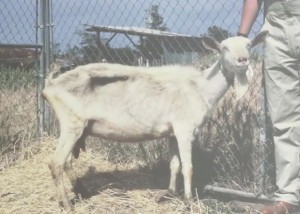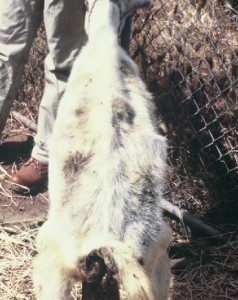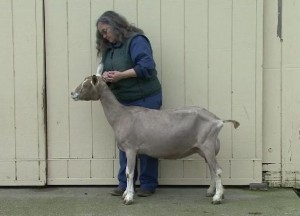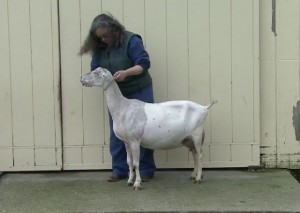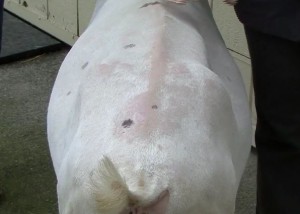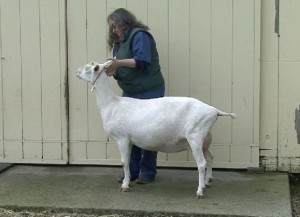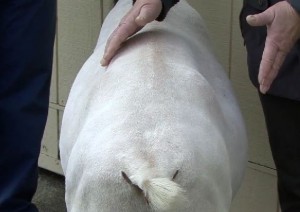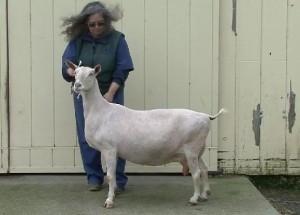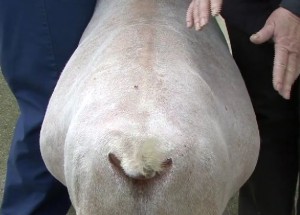This is a very informative video from the American Dairy Goat Association, the University of Calfornia Davis Department of Animal Science, and the UC Davis Department of Veterinary Medicine about body condition scoring in dairy goats. Body Condition Scoring (BCS) is used to manage the health and nutrition in a dairy goat herd by evaluating muscle and subcutaneous fat layering. This skill is essential to competently manage a herd of dairy goats. BCS is evaluated with a scale from 1-5, 1 being extremely emaciated and 5 being obese. Ideal range is 2-4. Here are some pictures and descriptions of each score from the video:
This Saanen doe is extremely thin and emaciated as a result of a chronic wasting disease. Note the extremely thin neck underline with the bone clearly visible. Her ribs above the point of elbow are clearly seen, as is the spinal process. Also note the hollow flank.
Note the prominent hips, spine and transverse process.
This 9 year old Toggenburg doe’s advancing age and peak lactation status likely contribute to her lean body condition. She has a minor degree of muscling around the brisket, base of neck, and shoulder. Her ribs are clearly defined above the point of elbow.
The bony contours of the hip and pinbones are easily observed. Note that the sharply demarcated features of the bones are observable because there is minimal subcutaneous tissue in this area. In the loin, the lack of musculature makes the transverse and dorsal processes clearly prominent.
BCS 3 side view
This LaMancha doe’s neck is lean and long, blending smoothly into the shoulder and brisket. Her ribs have a modest degree of fleshing, but are still visible.
Note that the hips and pinbones are clearly visible, but the contours are less well defined, due to the prescence of subcutaneous tissue. Additional musculature in the loin makes her dorsal spinous process less prominent; yet the contours of the dorsal and transverse spinous processes are still clearly visible.
The underline of this Saanen doe’s neck is smooth with some accumulation of flesh at the brisket. Her neck is smoothly blended by the precense of fleshing overlying the neck, shoulder, and ribs. Her ribs can be felt, but are no longer visible.
This doe’s hips and pinbones are rounded and smooth by the presence of overlying tissue. The dorsal and transverse processes are not prominent and the loin appears level from side to side.
Although this Saanen doe is not to the extreme of a body condition score of 5, approaches a 5 in body condition score. The underline of her neck appears shortened by the prominence of flesh extending up from the brisket. Fleshing bulges at the junction of the neck and shoulder. There is an extreme accumulation of fleshing over the ribs.
While this doe has prominent fleshing in the rump, for animals at the body condition score of 5, the excessive flesh covering the rump would protrude above the skeletal framework. In the loin, this doe demonstrates significant lack of the definition of the transverse and dorsal processes.
The American Institute for Goat Research at Langston University also has informative and helpful resources about goat BCS:


